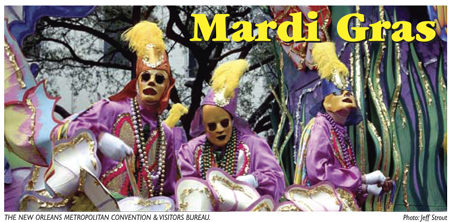
Noted
as the city is for jazz music, Cajun and Creole cooking, and the French
Quarter, Mardi Gras eclipses all as New Orleans’ most famous centerpiece.
It has arguably the greatest economic and cultural impact of any event
in the city.
A
time of revelry, fraternity, festivity and unabashed indulgence, Mardi
Gras reflects New Orleanians’ rich heritage, unleashes the joyous
soul of the city and invites everyone to join in the fun. The festival
embraces the city’s social and cultural variety, from the Mardi
Gras Indians to the Zulu parade to the Endymion ball, and brings everyone
together in the spirit of revelry.
2006
marks a monumental year for Mardi Gras in New Orleans. On this, the
150th anniversary of carnival in the city, Mardi Gras will be a very
special celebration of who we are and a joyful affirmation of our city’s
rebirth. It will be both a demonstration of and a catalyst for recovery.
It will invite the world to join in celebrating New Orleans’ colorful
past· and ushering in our bright new future
Mardi
Gras - How it Works
In
New Orleans, a town famous for its French Quarter and Bourbon Street,
for hot Cajun and Creole cuisine and for cool Dixieland jazz, one event
surpasses them all as the city's legendary signature piece - Mardi Gras!
It's a season of revelry and romance, of madness and music, of parades
and parties, of comic costuming in the streets and grandiose private
masquerade balls. Mardi Gras is a time when the gaudy and the gorgeous
all come together for one gigantic blowout. From the regal to the ridiculous,
the New Orleans Mardi Gras has it all!
Since
the first modern day pageant was presented in 1857, with time outs occasioned
by World Wars, more than 1,800 Mardi Gras parades have been staged in
metro New Orleans. The festival that was conceived as a party the city
threw for itself has grown into one of the world's grandest tourist
attractions. Yet for all its international fame, it can be difficult
for a first-timer to grasp. The celebration even has its own vocabulary,
and to make matters a bit more confusing, Mardi Gras is scheduled on
a different date each year! Perhaps the most surprising aspect of Mardi
Gras, however, is its connection to religion.
THE BASICS
Carnival,
loosely translated from Latin as "farewell to flesh," is the
season of merriment that starts in New Orleans each year on January
6, the Twelfth Night feast of the Epiphany - the day the three kings
visited the Christ Child. Mardi Gras, French for Fat Tuesday, is the
single-day climax of the season. While Mardi Gras undoubtedly has pagan,
pre-Christian origins, the Catholic Church legitimized the festival
as a brief celebration before the penitential season of Lent. The date
of Mardi Gras is set to occur 46 days before Easter and can fall as
early as February 3 or as late as March 9.
During
the 12 days preceding Mardi Gras, more than 60 parades and hundreds
of private parties, dances and masked balls are annually scheduled in
the metro area. Fat Tuesday is a legal holiday in New Orleans, a day
when half the town turns out in costume to watch the other half parade!
Then, promptly at midnight, the party's over, as Ash Wednesday ushers
in the austere Lenten season.
The
single custom that most distinguishes Mardi Gras parades is that of
throws - trinkets tossed from the floats - which turn New Orleans parades
into crowd participation events unmatched anywhere. "Throw Me Something
Mister" is the battle cry of the million-plus people who line the
parade routes. Most popular among the millions of throws are those that
illustrate the organization's logo and the parade's theme, including
plastic drinking cups, medallion necklaces and colorful aluminum coins
called doubloons.
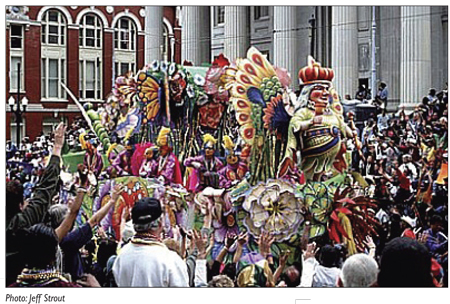
HOW
DOES IT WORK?
Mardi
Gras annually generates nearly half-a-billion dollars for the New Orleans
economy. Since no commercial or corporate sponsorships of Mardi Gras
parades are permitted, it is the Carnival club members who put on the
show and foot the entire bill.
Mardi
Gras organizations are non-profit clubs called krewes and many are named
after mythological figures such as Aphrodite, Eros, Hermes, Pegasus
and Thor. Each krewe is completely autonomous and there is no overall
coordinator of Carnival activities.
The
secrecy with which some of the older krewes cloak themselves is part
of the mystique of Mardi Gras. Several do not reveal the theme of the
parade until the night of the event, and the identity of their royalty
is never publicized. Most of the newer organizations take a more public
approach. Krewe members pay dues, ranging from $250-$850. In addition,
they spend as much as they wish on throws. Some krewes stage parades,
others present private tableau balls or bal masques (masquerade balls
in which scenes are acted out); many do both.
About
a dozen organizations dating from the 19th century use the Carnival
ball as the highlight of the debutante season, as daughters of the socially
elite members are presented at the city's Municipal Auditorium. Admittance
is by invitation only and formal attire is required. Newer organizations
have replaced the bal masque with lavish supper dances at the city's
finer hotels.
A
Carnival krewe is led by the captain, who is the permanent leader of
the group. Each year, a king and queen are selected to reign over the
parade. While most clubs select their royalty from within their own
ranks, krewes such as Bacchus and Endymion invite guest celebrities
to ride as their monarch or parade marshal. Stars such as Bob Hope,
Billy Crystal, Dennis Quaid, Wayne Newton, Tom Jones, Neil Sedaka, Paul
Anka, Dolly Parton, John Goodman and Harry Connick, Jr. have been so
honored. The recently established Krewe of Orpheus was founded by Harry
Connick, Jr.
There
is no overall theme for Mardi Gras, yet each individual parade depicts
a specific subject. Among the more popular are children's stories, mythology,
famous people, entertainment and literature. The 15-37 floats in each
procession are designed to illustrate the parade's theme, and the maskers
are costumed to reflect the title of each float. But Mardi Gras parades
are more than just floats. A 200-member parading krewe may actually
have 3,000 participants, including band members, motorcycle groups,
dance teams, clown units, etc.
THROUGH
THE AGES
While
its precise European origins are shrouded in mystery, Mardi Gras received
its first mention in North America in 1699. French explorer Pierre le
Moyne, Sieur d'Iberville camped on the Mississippi River on a spot 60
miles south of the present location of New Orleans. Knowing the date,
March 3, was being celebrated as a holiday in his native France, he
christened the site Point du Mardi Gras. During the next century, the
celebration of Mardi Gras included private masked balls and random street
maskings in the cities of Mobile and New Orleans.
By
the 1820s, maskers on foot and in decorated carriages began to appear
on Fat Tuesday, and in 1837 the first documented procession in New Orleans
occurred, but it bore no resemblance to today's Carnival.
The
modern-day celebration of Mardi Gras in New Orleans was born in 1857
with the flambeaux -- lit (torch-lit) nighttime parade of the Mystic
Krewe of Comus. In 1871, the Twelfth Night Revelers presented Mardi
Gras with its first queen. In 1872, Mardi Gras' first daytime procession
was presented by Rex, the King of Carnival. The event was partially
inspired by a visit from the Russian Grand Duke Alexis Romanoff, who,
legend has it, journeyed to New Orleans in pursuit of lovely singing
sensation Lydia Thompson, who was starring in the burlesque play "Blue
Beard."
The
show's favorite melody was "If Ever I Cease to Love." With
its nonsensical lyrics - If ever I cease to love, May cows lay eggs
and fish grow legs, If ever I cease to love... The crowds went wild!
It was played during the first Rex parade and has remained as the royal
anthem of Mardi Gras. Rex also gave Carnival its flag and its official
colors - purple for justice, gold for power and green for faith.
Les
Mysterieuses, Carnival's first female organization, staged its premiere
ball in 1896, but it was not until 1941 that the Krewe of Venus presented
the first ladies' Mardi Gras parade. In 1909, Zulu, Carnival's first
African-American parading krewe, was founded as a spoof of white Mardi
Gras. Its parade is now one of the early highlights on Fat Tuesday.
While
membership in parading organizations was once limited to only a few
citizens, the expansion of Mardi Gras into the suburbs and democratization
of Mardi Gras in the 1960s and 1970s opened up participation to virtually
everyone. Super krewes such as Bacchus and Endymion helped modernize
the festivities. In New Orleans there are krewes for men, women, men
and women, families and gays.
On
Fat Tuesday, about a dozen marching clubs cavort around town, including
the historic Jefferson City Buzzards, founded in 1890, and the celebrity-filled
Pete Fountain's Half-Fast Walking Club. For more than a century, the
elusive African-American Indian tribes such as the Wild Tchoupitoulas
and Yellow Pocahontas have also gathered on Carnival day. Their presentations
and chants as they show off their "new suits" is a Mardi Gras
day highlight.
Y'ALL
COME
But
after all is said and done, Mardi Gras remains an event and a spirit
that must be experienced to be understood. It's a mixture of centuries
- old traditions and high-tech innovations. From the bawdy behavior
of Bourbon Street to the family festival that Mardi Gras is everywhere
else, the Carnival season in New Orleans truly defies description. Perhaps
noted local author Don Lee Keith said it best: "In the truest sense,
it is magic. But magic revealed is magic destroyed. And that is why
the gods who made Mardi Gras dissolved the secret of that day in a chalice
of mystery, leaving their creation forever without definition."
THIS
FIRST SECTION "MARDI GRAS - HOW IT WORKS" WAS WRITTEN
BY ARTHUR HARDY, PUBLISHER OF THE ANNUAL MARDI GRAS GUIDE MAGAZINE.
THE ENTIRE ARTICLE IS PROVIDED AND PUBLISHED HERE WITH PERMISSION
OF THE NEW ORLEANS METROPOLITAN CONVENTION & VISITORS BUREAU
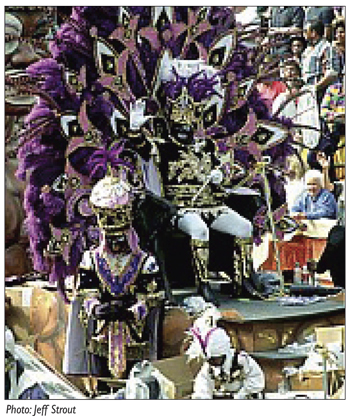
ORIGINS AND HISTORY OF MARDI GRAS
When
Iberville first set up camp near the future La Nouvelle Orléans,
he named the site Pointe du Mardi Gras. The date was Mardi Gras day,
1699.
Mardi Gras Crowd
Original
Revelers–The revels began (where so many revels did) in ancient
Rome. Long before the Christian era, young men in disguise roamed the
streets making merry during the winter Saturnalia. In the third century
A.D., the emperor Aurelius fixed December 25— the winter solstice
under the Julian calendar— as the birthday of the Invincible Sun,
which the Romans worshipped. The dates of the Saturnalia and the Sun
festival roughly collided, making for a weeklong, merry midwinter holiday
season.
A
couple of centuries later, the early Christian Church cleverly consolidated
and converted these pagan feasts (as it had so many others) to a Christian
holiday, declaring December 25 the birthday of the Son of God and Man.
They called it “Christ Mass,” or Christmas. The Epiphany,
the visit of the three kings to the Christ Child, was then celebrated
on January 6, the twelfth day after Christmas. In medieval Europe, the
Twelve Days of Christmas became a series of celebrations presided over
by an impromptu king of the festivities, the Lord of Misrule.
During
the revels, small tokens were distributed, suggesting the gifts brought
by the three kings. The goodies dispensed by the Lord of Misrule and
his court prefigure current carnival throws.
Bals
masqués, or masked balls, became the pinnacle of Twelfth Night
revelry in Renaissance Italy and spread to France and England. Early
New Orleans Creoles called them les bals des rois, for the kings who
presided over the masked merrymaking. A mock king for the night was
chosen by chance: whoever found a coin or a bean in a piece of special
“king cake” (named for the three kings and the king of Twelfth
Night), was crowned monarch of Twelfth Night. His queen he either chose
himself or was given through the luck of the draw: the girl who found
a pea in her cake was crowned consort. The cake, bean and pea are ancient
symbols of fertility.
Later,
the masques and entertainment continued through Shrove Tuesday, which
the French called mardi gras or “fat Tuesday,” the day before
Lent. Ironically, the solemn, austere period of Lent created Carnival,
which means literally, “farewell to meat.” All carnival
revelries began with the frenzied overindulgence of people about to
bid a temporary, but very fond, adieu to the pleasures of the flesh.
Another
irony, the date for Easter (which determines Lent and therefore Mardi
Gras) was determined by the Spring Equinox, a major pagan festival of
ancient Rome, which the early Church characteristically morphed into
a Christian feast day.
Mardi
Gras falls between February 3 and March 9, always 46 days before Easter—
the total of the 40 days of Lent plus the six Sundays in that period
(no abstinence on Sunday).
And
the date for Easter? It falls on the first Sunday after the full moon
following the Spring Equinox. Really.
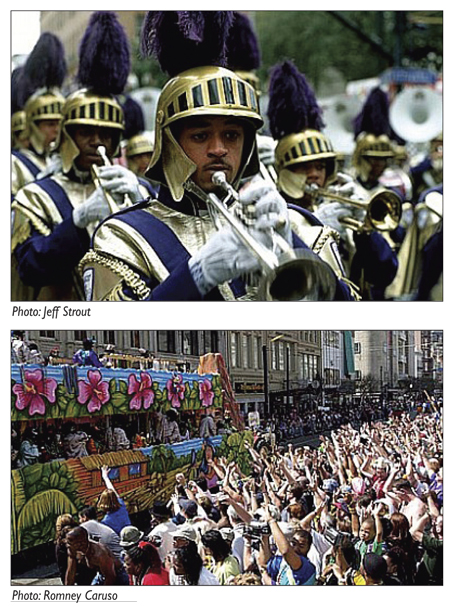
Carnival
Comes to the Crescent City
When
the French explorer, Pierre le Moyne, the Sieur de la Iberville, set
up a camp about 60 miles south of the future La Nouvelle Orléans,
he named the site Pointe du Mardi Gras. It was apropos, since the date
was March 3, 1699, Mardi Gras day.
The
Europeans brought their carnival customs, and Creole society was soon
masking and dancing at private balls while revelers in disguise roamed
the streets.
The
year 1837 marked the first documented procession of masked revelers
in New Orleans. By the mid 1840s, the carousing and drunken streetcapades
had grown so wild, relatively sober citizens lobbied to ban all public
carnival celebrations.
But
six men from Mobile, where Mardi Gras celebrations had been held as
early as 1708 and parades since 1831, stepped in. Together with thirteen
New Orleanians, they founded the first Mardi Gras organization and named
it for a reference to “Comus with his crew” from John Milton’s
poem, “A Mask Presented at Ludlow-Castle.” In Roman mythology,
Comus was the god of mirth and revelry. A follower of Dionysus, he was
represented as a drunken youth bearing a torch. In Milton’s poetic
masque, Comus is a rascal, the son of wine god Bacchus and Circe, daughter
of the Sun.
With
a little whimsy and archaic spelling, the Mobile Six formed the Mistick
Krewe of Comus, and in 1857 they paraded by torchlight on Mardi Gras
evening on two mule-drawn floats.
They
decided the parade wasn’t enough. The Krewe of Comus wanted something
grander to celebrate Mardi Gras, so they formed a secret society in
keeping with their Masonic origins, and issued 3,000 invitations to
a ball which became the event of the year for New Orleans society. The
first queen of Comus was Mildred Lee, daughter of Confederate general
Robert E. Lee, whose exploits the city still venerates with a monument
at Lee Circle.
The
parade and ball, with themes from mythology and literature, were so
successful that party-minded New Orleanians decided more was better,
and the krewes of Twelfth Night Revelers, Proteus, and Momus were formed.
Their parades rolled through dusky evenings and dark nights lit only
by torches. But that was about to change.
Russian
Rule Yet
It
was by sheer chance that Alexis Romanov, Grand Duke of Russia, landed
in New Orleans during Mardi Gras. The year was 1872, and he was in single-minded
pursuit of his latest amour, actress Lydia Thompson.
Nevertheless,
to celebrate his visit, a group of 40 businessmen funded a daytime parade
and called it “Rex,” Latin for “king.” The first
arrival of Rex was a surprise to most citizens. They learned of it on
Lundi Gras (the day before Mardi Gras) through an announcement in the
local newspapers ordering that normal business be shut down and the
city handed over to “Rex, King of Carnival.”
In
the duke’s honor, the newly formed Rex organization adopted the
Romanov family colors of purple, green, and gold (which represent justice,
fidelity, and power, respectively). They commissioned a band to play
the Duke’s favorite love song, “If Ever I Cease to Love,”
from the play Bluebeard, in which Thompson had a role.
After
Alexis left, the colors stuck, the gala day parade continued, and a
masked ball was added the next year in 1873. The song became the Mardi
Gras anthem and theme of Rex, who mounted a permanent throne as King
of Carnival and Monarch of Merriment with the motto Pro bono publico,
“For the common good.”
Amazingly,
Rex’s first arrival via riverboat at the foot of Canal Street,
is still repeated every Lundi Gras. The mayor turns the city and its
keys over to him in a public ceremony. That’s how Mardi Gras became
a legal holiday in New Orleans.
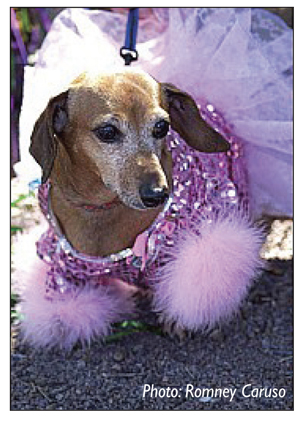
The
King of Cakes
King
cakes came to New Orleans with the French, who substituted a tiny baby
Jesus for the medieval bean. The cakes began as round, custard-filled
pastries decorated with crowns. (These have lately become popular once
again, made by French pastry shops around the city.)
Later,
a brioche pastry was rolled into an open circle like a crown, decorated
with jewel-like sugars, and it was in this form that the king cake became
a New Orleans carnival staple, made and served only between January
6 (the Feast of the Three Kings) and Mardi Gras.
Within
all New Orleans king cakes, there is either a bean or a small plastic
baby. At the Twelfth Night Revelers ball, which kicks off the carnival
season on January 6, whoever gets the golden bean is the queen. Her
maids are designated by silver beans. (Now, of course, the court is
chosen in advance, unlike their medieval counterparts who found the
tokens at random.)
For
two centuries, king cakes have been served at the Queen’s breakfasts
which follow private Mardi Gras balls. Guests at any party given in
the Mardi Gras season are almost guaranteed a slice of king cake. King
cakes are even appearing at New Year’s Eve feasts, a sweet finish
to the fireworks.
For
decades, the king cake set off a round of parties in the teen crowd.
Whoever got the baby or bean at the first soirée gave a king
cake party the following weekend. The chain continued until Mardi Gras.
In some circles, the tradition lives on.
MARDI GRAS LINGO
Coming
to terms with New Orleans.
Why
purple, green and gold for Carnival colors? When is “lundi gras”?
How did the word “krewe” originate? What’s a flambeau? Learn the
lingo and boeuf up your New Orleans vocabulary.
Ash
Wednesday - The first day of Lent, it’s the Wednesday
after Mardi Gras (Fat Tuesday). Catholics typically attend church, where
a priest blesses them by drawing a cross of ashes on the forehead, a
symbol of penitence and the frailty of life.
Ball,
bal masque - A masked ball, where a krewe’s court is
presented to the club members. Old-line krewes throw decorous balls,
often introducing debutante daughters of members. Attendance is by invitation
only and limited to krewe members and their guests. A few newer krewes
have refashioned the balls into bashes with celebrity guests and nationally
recognized entertainment. Some are open to the public for the price
of a ticket. To emphasize the new format they renamed the parties: Endymion
throws an Extravaganza, Bacchus a Rendezvous, and Orpheus, the Orpheuscade.
Boeuf
Gras (beuf grah) - French for “fatted bull.” Since
the Middle Ages, it has heralded the feasting and festivities that precede
the fasting and penitence of Lent. The fatted bull was killed on Monday,
and the crowds gorged themselves on their last meat, trying to consume
it all before midnight, when Lent began. The Boeuf Gras is a traditional
theme float in the Rex parade.
Call-outs - Partners for masked members of old-guard krewes are sent formal invitations
prior to each ball. They are then “called out” from the
audience to dance with the krewe members who invited them to the ball.
With each dance, krewe members give favors to their call-out partners.
Captain - The chief organizer of a carnival krewe or organization.
Carnival - From Latin, it literally means “farewell to meat.” Metaphorically,
it’s a temporary adieu to the pleasures of the flesh, as the multitudes
gather to overindulge before Lent. The carnival season begins on Twelfth
Night, January 6, and culminates on Mardi Gras day, Fat Tuesday.
Colors
of Mardi Gras - Because the first Rex parade honored a Russian
prince, the New Orleans Mardi Gras adopted the colors of the royal house
of Romanov: purple, green and gold for justice, faith and power, respectively.
Court
Ball Royalty - The king, dukes, queen, maids and pages. Only
the Court of Rex is called the “Carnival Court.”
Den - Once a secret location— generally a large warehouse.
It’s where a parade krewe’s floats are built and stored.
Doubloons - Commemorative coins struck for individual krewes. They are designed
with the krewe crest or emblem on one side and the parade and/or ball
theme on the other. Some also imprint mottoes; for Rex, it’s Pro
bono publico, “For the common good.” The Krewe of Rex tossed
the first parade doubloons in 1960. Now usually made of aluminum, some
have been minted of bronze, sterling and real gold, given as call-out
favors during balls. Rex alone has minted over eighteen million doubloons
since 1960, and now tosses out about 600,000 on Mardi Gras day.
Favor - Krewe souvenirs given by members to guests attending the ball. From
small costume jewelry pins to special doubloons, favors can be anything
a krewe member wants to give his partner. On occasion, favors have even
been extravagant items of real jewelry.
Flag - Notice the purple, green and gold flags flying outside homes around
the city? Only former kings and queens of carnival have the right to
fly the ones with crowns. The Crescent City is full of past, present
and future royalty.
Flambeaux
(plural, flam-boe) - Multipronged long metal torches fueled
by naphtha or kerosene and secured by straps slung about the waist.
Before portable generators and battery-operated lights, they were the
only way to illuminate the floats of night parades. Traditionally carried
by white-robed African Americans, they began as a symbol of Haiti’s
independence, won in 1791, after slaves held a torchlight parade led
by their priests.
Floats - Mobile platforms or trucks, each extravagantly decorated to depict
one subject related to the parade’s theme that year.For instance,
Pinocchio might dominate a float in a parade of fairytales or children’s
literature. Popular theme areas include mythology, history, fairytales,
and pop culture. Masked krewe members dressed in keeping with the parade
theme or float subject toss a variety of throws to the crowds below.
Go-Cup - Plastic or paper cup. It’s legal to drink alcohol in the streets
of the Big Easy as long as the container isn’t breakable. If you’re
going to stroll and drink, ask the bartender for a go-cup.
King
Cake - A party staple from January 6 through Mardi Gras day,
the cake is named for the three kings who visited the Christ Child and
whose feast, the Epiphany, is celebrated on January 6, the Twelfth Night
after Christmas. Traditionally, the cake is a brioche pastry baked in
a circle, suggesting a crown (although for convenience, large ones are
oval). They are sprinkled with gem-like sugar crystals in the official
Mardi Gras colors of purple, green and gold. A plastic baby (symbol
of the Christ Child), or in some cases a bean, is baked inside. By custom,
the one who finds it throws the next king cake party. Lately, the brioche
recipe has been supplemented by a coffee-cake ring alternative. French
settlers brought the gâteau des rois to Louisiana in the 18th
century. Their original round, flaky pastry pie filled with almond crème
and topped by a paper crown, is now making a comeback in the French
pastry shops around the city.
Krewe - A variation of the word “crew,” most carnival organizations,
all are private and non-profit, are known as krewes. The word was invented
with a little creative spelling in 1857 by the first New Orleans carnival
organization. The founders of the Mistick Krewe of Comus, named their
group for a reference to “Comus with his crew” from John
Milton’s poem, “A Mask Presented at Ludlow-Castle.”
A few parading organizations are not called krewes: Rex, Bacchus, Knights
of Babylon, Knights of King Arthur, Corps de Napoleon, Zulu Social Aid
and Pleasure Club.
Lundi
Gras - French for “Fat Monday,” it’s the
day before Mardi Gras, and the revels intensify after the weekend parades.
Today, both Rex, King of Carnival and the King and Queen of Zulu arrive
via riverboats. The City of New Orleans hosts a free bash in Spanish
Plaza outside Riverwalk, where the live entertainment features some
of the Big Easy’s best musicians. During the festivities, the
mayor presents the keys of the city, declaring Mardi Gras a legal holiday
and the domain of Rex, who officially begins his reign of merry madness.
The party shifts into high gear with great food and fireworks. In the
evening, the venerable Proteus and spectacular Orpheus parades roll.

Mardi
Gras, Fat Tuesday - Rex rules, but marching clubs like the
Jefferson City Buzzards and Pete Fountain’s Half Fast Marching
Club meander around town, alternating between playing and hitting the
bars while they trade beads or paper flowers for smooches. Parades other
than Rex roll through the city— Zulu, the Krewe of Elks and the
Krewe of Crescent City in New Orleans, and others make merry in Metairie
and in adjacent parishes. The masses don costumes skewed from elegant
to outrageous. The elaborate regalia of the Mardi Gras Indians flash
across the landscape in neighborhoods throughout the city. And downtown,
the Bourbon Street Awards go to the best transvestite costume, usually
loaded with more spangles than a Liberace ensemble and more elaborate
headdress than a Las Vegas showgirl. No matter how wild, the celebrations
end at midnight, when Ash Wednesday begins.
Mardi
Gras Indians - Beginning in the 18th century, runaway slaves
were sometimes taken in by local Native Americans. In homage to their
saviors, African Americans began to band together in tribal krewes like
the Wild Magnolias, Wild Tchoupitoulas, and the Wild West, headed by
chiefs rather than captains. Fashioning the incredibly elaborate costumes
of feathers and beads, is a family affair, and the custom is handed
down from father to son. The feathered show usually takes wing near
Claiborne and Orleans Avenues.
Maskers - Masked and costumed krewe members in parades or at balls.
Neutral
Ground - Grassy medians where crowds stand to watch the parades
and beg shamelessly for carnival throws. When the Americans arrived
in New Orleans after the Louisiana Purchase of 1803, they were unwelcome
to the Europeans and Creoles who inhabited the French Quarter (then,
the entire city of New Orleans). So the immigrants settled across Canal
Street and established what is now the Central Business and Arts District.
Canal Street then became the “neutral ground” in the clash
of cultures. Ever since, New Orleans has been a city sans medians. Here,
we have only neutral grounds. In case you’re wondering, cars parked
on the raised neutral grounds mean only two things: imminent and nearby
parades or a forecast of rain.
Parade - A procession of floats, maskers, horses, motorcycles, marching bands,
flambeaux carriers and dancers. Parades begin about twelve days before
Mardi Gras and end on Mardi Gras Day.
Rex
King of Carnival - Rex is Latin for “king,” Also
known as the “Monarch of Merriment,” Rex officially misrules
over Mardi Gras having received the keys to city from the mayor on Lundi
Gras. He is chosen by the inner circle of the School of Design, the
organization that sponsors the Rex parade. His identity is a closely
guarded secret until Mardi Gras day, when the local papers flash photos
of him and his queen across the front pages.
Tableau - A scene enacted by masked krewe members at a Carnival ball. Staged
before the dancing, it depicts the parade and/or ball’s theme.
Think of it as a short, short, one-act mime.
Throws - Typically, plastic beads and cheap trinkets hurled by masked krewe
members from passing floats. The usual suspects include beads (from
plain round beads in Mardi Gras colors to light-upand- flash crawfish
and other swamp inhabitants), doubloons and plastic cups. However, depending
on the parade, the generosity of the masker, and the appeal of the crowd
member, an energetic parade watcher could catch a rose, a stuffed animal,
an Opheus virbloon (a virtual doubloon: a CD with video highlights of
the previous year’s parade footage), a plastic alligator, rubber
snake, a Zulu coconut, spear, a krewzer (whirling disc of polyester
that converts to a throw bag), and dozens of other interesting little
and large tchotchkes.

Mardi
Gras FAQ's
When is Mardi Gras?
This year's Mardi Gras celebration is scheduled to begin February 23,
2006, a Thursday, and run through Fat Tuesday, February 28. Final decisions
will not be made until after November 18, 2005, when all Carnival krewes
are to notify the city whether they intend to parade.
Is
Mardi Gras Really X-rated?
No, it is not. Unfortunately, the wild antics of visiting coeds on Bourbon
Street in the French Quarter have gained such publicity that they have
become the national image of Mardi Gras. Mardi Gras is generally a safe,
G-rated event enjoyed by families. The festivities provide an opportunity
for adults to act like kids again.
What
Makes Mardi Gras Parades Different?
Throws! Baubles tossed from floats turn New Orleans parades into crowd
participation events. It is not uncommon for a float rider to spend
$500 or more on beads, cups and doubloons, which are freely thrown to
parade viewers.
Is
Mardi Gras Staged for Visitors?
Not really. While the "greatest free show on earth' draws hundreds
of thousands of visitors, that is not its purpose. Mardi Gras is a party
the city throws for itself. It has developed into a world-class tourist
attraction, yet the City of New Orleans doesn't spend a cent promoting
it.
What
Companies Sponsor Mardi Gras?
They don't. Mardi Gras is the only entertainment venue in the world
where the stars foot the bill and the audience gets a free ride. By
tradition and by law, Mardi Gras parades in New Orleans may not be corporately
sponsored. Carnival clubs are chartered as nonprofit organizations.
They are financed by dues, by the sale of krewe-emblemed merchandise
to the members, and by fundraising projects such as bingos.
Why
Can't I Buy an Official Mardi Gras Poster?
There is no such thing. Unlike the Olympics or the SuperBowl, there
is no governing authority to license products. Mardi Gras is like Christmas
and Halloween -- it belongs to everyone. Beware of any item that bears
the title "official." The claim (and the product?) are bogus.
Free enterprise reigns supreme over Mardi Gras, making it a virtual
paradise for entrepreneurs who compete for counter space and the attention
of the public.
Who
Coordinates Mardi Gras?
No one. While city governments issue parade permits, there is no overall
authority that coordinates the five dozen parades held in the metro
area during the 12 days that precede Fat Tuesday. Each parading organization
is completely autonomous.
Why
Are There No Parades in the French Quarter?
For 117 years, virtually every New Orleans Mardi Gras parade rolled
through the French Quarter. In 1973 the fire and police departments
felt that the increased size of parade floats, and the crowds that gathered
to see them, rendered the narrow streets unsafe, so the city issued
a ban on parades in that historic area.
What's
the Difference between Carnival and Mardi Gras?
Carnival refers to the season of merriment which always begins on January
6. Mardi Gras (Fat Tuesday) is the single culminating day of Carnival
and it is always the day before Ash Wednesday.
Is
Mardi Gras Really Connected to Religion?
Yes. The Catholic Church licensed Carnival, which means "farewell
to flesh," as a period of feasting before the fasting of Lent.
The Church also established the set date for the start of the Carnival
season—January 6, the Feast of the Epiphany —and the fluctuating
date of Mardi Gras.
Why
Does the Date of Mardi Gras Change?
Because it's connected to the moveable date of Easter, which can fall
on any Sunday from March 23 to April 25. Mardi Gras is scheduled 47
days preceding Easter and can occur on any Tuesday from February 3 through
March 9.
When
Was the First Mardi Gras Parade Held in New Orleans?
On February 24, 1857. The Mistick Krewe of Comus, Carnival's first secret
society, coined the word "krewe" and was the first to choose
a mythological namesake, to present a themed parade with floats, and
to follow it with a tableaux ball.
Is
it True Mobile Celebrated Mardi Gras before New Orleans?
Yes and no. New Orleans' first Carnival krewe was founded in 1857 by
former members of Mobile's Cowbellian de Rakin Society, which was founded
in 1830. However, Mobile's parades were held on New Year's Eve until
1866, when they switched to Fat Tuesday.
Has
Mardi Gras Ever Been Canceled?
Yes, but not often. Since 1857, only 13 Fat Tuesdays have been effected.
Most cancellations were caused by wars: Civil, WWI, WWII and Korean.
Krewes
Are Named after What?
The colorful worlds of Greek, Roman and Egyptian mythology are the sources
of nearly half of the parading krewe names. Other clubs are named after
the neighborhoods through which they travel, while some are named after
historical figures or places.
What
Do the Carnival Colors Mean?
Purple represents justice, green stands for faith, and gold signifies
power. Rex, the King of Carnival, selected them in 1872 for his first
parade. While they were probably chosen simply because they looked good
together, Rex assigned a meaning to each in his 1892 parade, entitled
"Symbolism of Colors."
What
Are Balls and Why Can't I Go?
Carnival balls are private formal affairs (tuxedos and long gowns required)
and are by invitation only. Bals Masque (masked balls) in New Orleans
predate the first parade by more than a century. More than 125 private
balls are presented each season in the city's Municipal Auditorium and
in the grand ballrooms of major hotels. Mock royalty reigns over each
ball, where a king, queen, maids and dukes are presented. In the older
society krewes, the court is made up of debutantes.
Some
clubs stage "tableaux" (theatrical scenes) enacted by krewe
members, and favors are given to special guests. Krewes such as Bacchus,
Orpheus, Endymion and Zulu have replaced the traditional ball with extravaganzas
presented at the Louisiana Superdome and at the Morial Convention Center.
Tickets are sold to these events.
What's
the Theme for this Year?
There is no general theme for Mardi Gras, but each individual parade
depicts a specific subject. The floats then reflect the krewe's theme
for that year. Maskers are costumed in a manner that illustrates the
overall parade theme and the individual float title. Among the more
popular subjects have been history, children's stories, legends, geography,
famous people, entertainment, mythology and literature.
Do
I Have to Mask?
No, but you should, at least on Fat Tuesday, the only day when street
masking is legal (from dawn to dusk). Masking, which can be elaborate
or makeshift, dates from Roman carnivals when assuming false identifies
was a common practice. By law, float riders must be masked at all times.
How
Do I Get to be King?
If you're not a krewe member or a celebrity, you don't. The method of
selecting Mardi Gras royalty varies from krewe to krewe. The King of
Carnival is chosen by the inner circle of the School of Design, the
sponsoring organization for the Rex parade. Some krewes hold random
drawings to pick their king or queen. Most clubs charge the selected
monarch a fee to reign. In several of the newer krewes, elaborate ceremonies
called "coronation balls" are staged to crown their royalty.
Is
Secrecy Still a Part of Carnival?
Yes. While many Carnival clubs are fairly accessible (some even have
websites), most maintain the tradition of secrecy that has been a part
of Mardi Gras since its earliest days. A unique custom in the older
organizations is that the king's name is never made public. An exception
is Rex, whose name is revealed the day before his parade. And while
many in the media know his identity days in advance, the embargo on
publishing it has never been violated.
What
about Celebrities?
The Krewe of Bacchus began the tradition of selecting celebrity kings
with its first parade in 1969, when Danny Kaye reigned. Endymion and
Orpheus also annually invite guest celebrities to ride in their parades.
Some of the more popular stars to have appeared are Bob Hope, Dolly
Parton, Wayne Newton, John Goodman, Jackie Gleason, Britney Spears,
Kirk Douglas, Harry Connick Jr., Nicholas Cage and the Beach Boys. In
most cases visiting stars are not paid to ride, although the krewes
do cover their expenses.
Is
the Success of Mardi Gras Measured by the Amount of Trash Collected?
No. Before the age of recycling, the success of Mardi Gras in Orleans
Parish was sometimes jokingly measured by the amount of trash collected
by the New Orleans Sanitation Department. For several years in the late
1980s, the total for the 12-day parading season topped the 2,000-ton
mark.
Is
Mardi Gras Elitist?
Not any more. While wealthy white males once controlled Carnival (and
most of America), Mardi Gras is one of the nation's most diverse institutions
and it offers a rich cultural experience to participants and spectators.
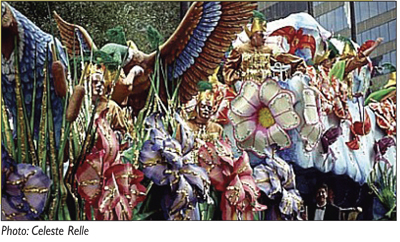
Mardi
Gras Indians
"Mardi
Gras Indians--the parade most white people don't see. The ceremonial
procession is loose, the parade is not scheduled for a particular time
or route...that is up to the Big Chief."
- Larry Bannock
Typical
Mardi Gras organizations will form a "krewe." A krewe often
names their parade after a particular mythological hero or Greek god.
The ranking structure of a Mardi Gras Krewe is a parody of royalty:
King, Queen, Dukes, Knights and Captains...or some variation on that
theme. Many more established Krewes allowed membership by invitation
only.
Few
in the ghetto felt they could ever participate in the typical New Orleans
parade. Historically, slavery and racism were at the root of this cultural
separation. The black neighborhoods in New Orleans gradually developed
their own style of celebrating Mardi Gras. Their "Krewes"
are named for imaginary Indian tribes according to the streets of their
ward or gang.
The
Mardi Gras Indians named themselves after native Indians to pay them
respect for their assistance in escaping the tyranny of slavery. It
was often local Indians who accepted slaves into their society when
they made a break for freedom. They have never forgotten this support.
In
the past, Mardi Gras was a violent day for many Mardi Gras Indians.
It was a day often used to settle scores. The police were often unable
to intervene due to the general confusion surrounding Mardi Gras events
in the city...where the streets were crowded and everyone was masked.
This kept many families away from the "parade," and created
much worry and concern for a mother whose child wanted to join the "Indians."
"'I'm
gonna mask that morning if it costs me my life!' That morning you pray
and ask God to watch over you, cause everybody is bucking for number
one." - Larry Bannock
Today
when two Mardi Gras Indian tribes pass one another, you will see a living
theater of art and culture. Each tribe's style and dress is on display...in
a friendly but competitive manner, they compare one another's art and
craftsmanship.
The
greeting of the Big Chiefs of two different tribes often starts with
a song, chant, ceremonial dance, and threatening challenge to "Humba"--the
Big Chief's demand that the other bow and pay respect. The retort is
a whoop and equally impressive song and war dance with the reply, "Me
no Humba, YOU Humba!"
"You
know when you've won, you see it in their eyes." - Larry Bannock
Although
there was a history of violence, many now choose to keep this celebration
friendly. Each Big Chief will eventually stand back and, with a theatrical
display of self-confidence, acknowledge the artistry and craftsmanship
of the other's suit. Before the progression can continue, the two Big
Chiefs will often comment privately to one another, "Looking good
Baby, looking good!"
"After
Mardi Gras, you thank GOD that you made it." - Larry Bannock
Mardi
Gras is no longer a day to "settle scores" among the
Mardi Gras Indians. Violence is a relic of the past. It is now Mardi
Gras tradition and practice for the Indians to simply compare their
tribal song, dance and dress with other tribes as they meet that day.
Each Indian has invested thousands of hours and dollars in the creation
of his suit, and is not willing to risk ruining it in a fight. This
tradition, rich with folk art and history, is now appreciated by museums
and historical societies around the world. It is a remarkable and welcome
change from the past.
The
history and culture of the Mardi Gras Indians is a significant part
of Mardi Gras and New Orleans -- yet until now, it has been the least
appreciated and least understood. We hope you enjoy reading about it
as much as we have enjoyed bringing it to you! We thank the Mardi Gras
Indian Council for opening their history books, and sharing their history
and traditions with us!
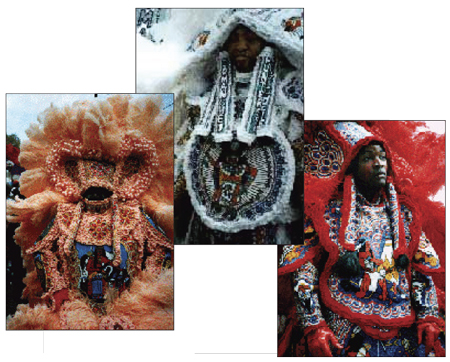
© 2015 TLC Magazine Online, Inc. |